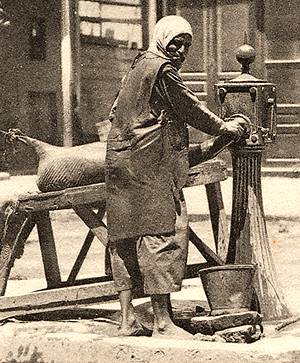

When the celebration was over, some of the cities reverted back to the traditional colors. Some made them up in the colors of the flag, while others dressed them as historic figures, according to the website of the city of South Bend, IN.

Many communities apparently started painting their fire hydrants in patriotic colorsaround the time of the country’s Bicentennial in 1976. Painting hydrants publicly seems to be a pretty popular pastime in many cities, especially as contests to get citizens involved. Inside, you’d have to clean and then paint them a color to blend in with your home’s décor. Outdoors, you could retain their grimy patina, which gave them character and history.
.jpg)
Since I’m not into collecting them, I automatically tried to think of ways to transform the ones at auction into decorative art for the home or yard. The website offered tips on collecting and restoring them, along with photos from some of the collections. And so are fire hydrants. Some collectors have so many of them that they have opened their own private museums, according to a website for such collectors. I should’ve known better, because just about everything is collected. They’re so heavy and bulky, it never occurred to me that they were collectible. At auction, they were looking for a new home. These old fire hydrants look as if they’ve been put to good use. I had never seen vintage fire hydrants offered at auction before, so I wasn’t sure what to make of them. They looked to be old and much used, so I assumed that they were replaced by newer and more efficient models. How the heck did they end up in a back yard lot at this auction house? Did some fire department toss them in the trash after they’d burned out, and someone retrieved them? Or were they sold for scrap?

No quick answer popped into my head, but another question did. I stood there looking at them, wondering: How exactly do you re-use old fire hydrants? More important, you see the same thing you see in these images from The Times’s archives: how drastically water can transform a neighborhood that’s desperate for relief.I was about to walk right past the two rusted fire hydrants, but stopped. You see two young men rubbing the tops off cans on the sidewalk so they can use them to aim the water like a fire hose. There’s a boisterous scene with a flowing hydrant in Spike Lee’s 1989 movie, “Do the Right Thing.” The level of detail is striking, starting with the real-life Times headline shown in the film: “Yes, It’s Hotter, It’s Muggier, and, Yes, You’re Going Crazy.” You see a fireplug opened with a wrench. “Yesterday,” The Times reported, “Police Headquarters issued air raid helmets to all members of the force with orders to put them on before raiding illegally opened fire hydrants.” On June 9, 1933, about 400 young people demonstrated in front of the police station on West 47th Street, protesting officers for shutting down hydrants down during heat waves.īy July 4, 1961, tempers and temperatures were such that residents hurled rocks and bottles at officers when they arrived with wrenches. Later, he remembered in his autobiography the “gasping misery of the little children and of the worn-out mothers” and compared the scene to a cholera epidemic. Theodore Roosevelt, then the city’s 37-year-old police commissioner, became something of a hero by handing out ice in alleys behind the tenements. The mayor had declined to lift the ban on sleeping in parks and didn’t assemble his team to strategize until the 10th day of the heat wave. At least 1,300 people died in New York City from the heat, many of them immigrants working 60 hours or more a week. Much of the rancor stemmed from the fact that New York’s poor ranked low among the city’s priorities - and knew it.ĭuring the catastrophic days of August 4-13, 1896, it was as hot as 120 degrees inside the tenements on the Lower East Side of Manhattan. But even after the city began distributing sprinkler caps in the 1950s to reduce the amount of wasted water, fireplugs continued to be opened illegally, becoming a source of tension and sometimes violence. The exuberant photographs you see here were shot by The Times throughout the 20th century, running with captions such as “Cooling Off City-Style” and “AH! THAT FEELS GOOD!” One caption writer was even moved to pronounce the fire hydrant as “the lifeline of summer, spewing cooling excitement to all around it.” That is certainly true.


 0 kommentar(er)
0 kommentar(er)
